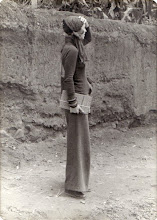“The display of powerful objects in vitrines and the desire to make use of their energy for a didactic exhibition displaces them and makes them enigmatic.” Baumgarten, Unsettled Objects – 1968-9
Many artists have explored the conceptual possibilities of the vitrine, plith, label, and public space of the museum as medium (Putnam), elevating objects from their everyday triviality through display as did Haim Steinbach, or by making it the object of their career to "epitomize and burlesque the art game's pell-mell institutional, commercial and academic expansion"as did Martin Kippenberger, according to Peter Schjedahl and seen in his current MOMA retrospective. Although many artists chose to leave established museums in the dust, creating their own (Claes Oldenberg's Mausmuseum and Duchamp's self-referential ironies), or creating pieces that slipped through their fingers (literally, as the gold leaf payment for Yves Klein's Sensibilité Picturale Immédiate fell into the Seine, and the certificate was burned), others chose to engage the powerful space head on - either through their own work or through the collections to highlight the links between the culture and unseen politics of the art world. Mark Dion evenpreferred to work with museums for their connection with the wider public, letting the "viewer complete the work".
Some curatorial wonders: artist-curated shows - Joseph Kosuth - Play of the Unmentionable, Brooklyn Museum, 1990. - Andy Warhol - Raid the Icebox I with Andy Warhol - another more obvious, ludic approach. - Fred Wilson - Mining the Museum, Maryland Historical Society, or Mixed Metaphors in Seattle - a more subtle approach, playing on the historiography of art.
In many ways the museum is a mash-up or petri dish of Bourdieu's concepts of the art world. As the field of production and value-creation, the "neutral space" of the museum's white cube and institutional structure is in fact highly connected to the fields of class, power and economics. The increasing self-reflexivity of museums and their curators have led to reexamining of collections and practices both internally through carefully researched exhibits and development projects, and from outside sources such as artist curators, scholars and educators. By making room physically, financially and and in their schedules for such interventions, rather than simply housing work or validating the position of agents in the art world, museums have in some ways created a new breeding ground for art. By commissioning Stephen Antonakos to cover the exterior of the Fort Worth Art Museum in Texas with 10 outdoor neons in 1974, the then-director Richard Koshalek increase the museum's dynamism and visibility despite its galleries being booked for the next three years.
Yet museums' efforts to address criticisms of out-of-touch elitism often put them in a tenuous position between maintaining their "power to consecrate [...]" and allowing the artist, curator, public and critic to dig up their skeletons and expose their not-so-neutral inner workings. Hans Haacke'sTaking Stock made relevant the infiltration of corporate interests in the collection process, and led to the resignation of Charles Saatchi from the Tate's board. While John Baldessari curated Ways of Seeing from the 90% of the Hirshhorn's collection which remains in storage, pieces such as Janine Antoni's chocolate bust in the series "Lick and Lather" were kept from circulation, and thus cultural reanimation.
And a new wave of criticism abounds for those trying to lift the current economic damper by turning to more market aware schemes... Even the plans for a string of museums designed by Gehry in Abu Dahbi, Vienna and other places has been put on hold by trustees and financial gaps. That being said, not all private projects are sell-outs, or impossible models for public institutions - e.g. Di Rosa PreserveNonetheless, some managed to strike a balance between financial sustainability, transparency and the dynamic artistic avant-garde... like MOCA's Temporary Contemporary, leased for 1$/year from LA, also initiated by Koshalek when he was Director there - originally a hardware building, it was incidentally redesigned by Gehry. Or the Hirshhorn's AfterHours, geared towards younger audiences and a great media plug. Once the museum is admittedly no longer 'just' the White Box, thinking outside the box can be a springboard for institutional change.
PS. next AfterHours March 27th at Hirshhorn. [[4]] PPS. one-hit wonder? An artist-created gift-shop at MOCA-Lyon (France) Warhol show, L'Oeuvre Ultime in 2005, where the walls were covered in baubles and 5-and-dime plastics, by a French artist mostly known for his aphoristic quips on every student's planner/agenda - Andre?? - a temporary structure, I ended up spending more time in it than in the entire exhibit - until I find an image, just know that it was reminiscent of:
[[5]]





Aucun commentaire:
Enregistrer un commentaire